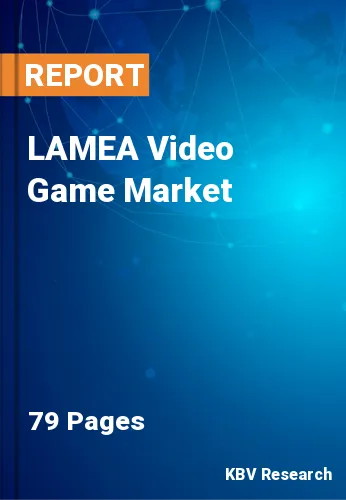Chapter 1. Market Scope & Methodology
1.1 Market Definition
1.2 Objectives
1.3 Market Scope
1.4 Segmentation
1.4.1 LAMEA Video Game Market, by Type
1.4.2 LAMEA Video Game Market, by Device
1.4.3 LAMEA Video Game Market, by Country
1.5 Methodology for the research
Chapter 2. Market Overview
2.1 Introduction
2.1.1 Overview
2.1.1.1 Market Composition and Scenario
2.2 Key Factors Impacting the Market
2.2.1 Market Drivers
2.2.2 Market Restraints
Chapter 3. Competition Analysis - Global
3.1 KBV Cardinal Matrix
3.2 Recent Industry Wide Strategic Developments
3.2.1 Partnerships, Collaborations and Agreements
3.2.2 Product Launches and Product Expansions
3.2.3 Acquisition and Mergers
3.3 Top Winning Strategies
3.3.1 Key Leading Strategies: Percentage Distribution (2018-2022)
3.3.2 Key Strategic Move: (Partnerships, Collaborations and Agreements: 2018, Nov – 2022, Jan) Leading Players
Chapter 4. LAMEA Video Game Market by Type
4.1 LAMEA Offline Market by Country
4.2 LAMEA Online Market by Country
Chapter 5. LAMEA Video Game Market by Device
5.1 LAMEA Mobile Market by Country
5.2 LAMEA Console Market by Country
5.3 LAMEA Computer Market by Country
Chapter 6. LAMEA Video Game Market by Country
6.1 Brazil Video Game Market
6.1.1 Brazil Video Game Market by Type
6.1.2 Brazil Video Game Market by Device
6.2 Argentina Video Game Market
6.2.1 Argentina Video Game Market by Type
6.2.2 Argentina Video Game Market by Device
6.3 UAE Video Game Market
6.3.1 UAE Video Game Market by Type
6.3.2 UAE Video Game Market by Device
6.4 Saudi Arabia Video Game Market
6.4.1 Saudi Arabia Video Game Market by Type
6.4.2 Saudi Arabia Video Game Market by Device
6.5 South Africa Video Game Market
6.5.1 South Africa Video Game Market by Type
6.5.2 South Africa Video Game Market by Device
6.6 Nigeria Video Game Market
6.6.1 Nigeria Video Game Market by Type
6.6.2 Nigeria Video Game Market by Device
6.7 Rest of LAMEA Video Game Market
6.7.1 Rest of LAMEA Video Game Market by Type
6.7.2 Rest of LAMEA Video Game Market by Device
Chapter 7. Company Profiles
7.1 Electronic Arts, Inc.
7.1.1 Company Overview
7.1.2 Financial Analysis
7.1.3 Research & Development Expenses
7.1.4 Recent strategies and developments:
7.1.4.1 Partnerships, Collaborations, and Agreements:
7.1.4.2 Acquisition and Mergers:
7.2 Nintendo Co., Ltd.
7.2.1 Company Overview
7.2.2 Financial Analysis
7.2.3 Segmental and Regional Analysis
7.2.4 Research & Development Expenses
7.2.5 Recent strategies and developments:
7.2.5.1 Product Launches and Product Expansions:
7.3 Rovio Entertainment Corporation
7.3.1 Company Overview
7.3.2 Financial Analysis
7.3.3 Segmental and Regional Analysis
7.3.4 Recent strategies and developments:
7.3.4.1 Acquisition and Mergers:
7.4 Microsoft Corporation
7.4.1 Company Overview
7.4.2 Financial Analysis
7.4.3 Segmental and Regional Analysis
7.4.4 Research & Development Expenses
7.4.5 Recent strategies and developments:
7.4.5.1 Partnerships, Collaborations, and Agreements:
7.5 Lucid Games Ltd.
7.5.1 Company Overview
7.6 Tencent Holdings Ltd.
7.6.1 Company Overview
7.6.2 Financial Analysis
7.6.3 Segmental and Regional Analysis
7.6.4 Research & Development Expenses
7.6.5 Recent strategies and developments:
7.6.5.1 Acquisition and Mergers:
7.7 Activision Blizzard, Inc.
7.7.1 Company Overview
7.7.2 Financial Analysis
7.7.3 Segmental and Regional Analysis
7.8 Sony Corporation (Sony Interactive Entertainment LLC)
7.8.1 Company Overview
7.8.2 Financial Analysis
7.8.3 Segmental and Regional Analysis
7.8.4 Research and Development Expense
7.9 Apple, Inc.
7.9.1 Company Overview
7.9.2 Financial Analysis
7.9.3 Regional Analysis
7.9.4 Research & Development Expense
7.9.5 Recent strategies and developments:
7.9.5.1 Product Launches and Product Expansions:
7.10. The Walt Disney Company (Hulu LLC)
7.10.1 Company Overview
7.10.2 Financial Analysis
7.10.3 Segment and Regional Analysis
7.10.4 Recent strategies and developments:
7.10.4.1 Partnerships, Collaborations, and Agreements:
7.10.4.2 Product Launches and Product Expansions:

